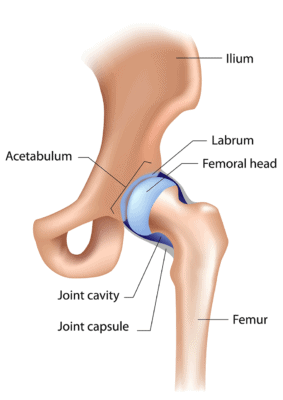If You Have a Hip Labrum Tear, You May Also Have a Shoulder Labrum Tear?
Labral tears are always something that freak patients out. Why? Just the concept of something torn in your hip or shoulder is disconcerting. However, now a new study shows that if you have a tear in your hip labrum, you’re more likely to have one in your shoulder. Let’s dig in.
Understanding Labrum Tears and FAI?

Alila Medical Media/Shutterstock
Both the hip joint and shoulder joint have a structure called a labrum. In both cases, it lines the rim of the socket where the ball portion fits into the socket portion. The labrum helps provide stability. Similarly to the meniscus in the knee, tears from either wear and tear with aging or trauma can occur.
Femoroacetabular impingement (FAI) is a condition in the hip joint that occurs when a bone spur develops on the hip joint. The idea with FAI is that the ball or socket of the hip joint has become misshapen, causing tears in the hip labrum. So surgeons love to get in there and lop of the bone spurs, reshape the socket, and repair the tears. Unfortunately, there’s very little research evidence that supports FAI and hip labrum surgery and a great deal of research evidence that doesn’t. Learn more about this in my brief video below:
Now, research shows a link between labrum tears in the two seemingly otherwise unrelated joints, the hip and shoulder. Let’s review.
Hip Labrum Tear and FAI Patients More Likely to Have Shoulder Labrum Tear
A new study compared patients undergoing hip labrum repair (for labrum tear) and femoroacetabular osteoplasty (FAO, for FAI) to patients undergoing ACL repair (the control group). They found that 12% of those with who had the hip labrum repair and FAO also had a tear in the shoulder labrum compared to only 3.3% in the ACL repair control group. This means the hip labrum repair and FAO group were nearly four times as likely to have an accompanying shoulder labrum tear. In addition 80% of the shoulder labrum tears in the ACL group could be explained by a trauma; whereas, only 43% were traumatic in the FAO/labrum repair group.
So what’s causing all those other shoulder labrum tears, and why are they so much more prevalent in those with hip labrum tears due to FAI? These are, after all, two joints that, logistically speaking, are nowhere close to one another.
One possibility is that they have loose ligaments, so that impacts the labrum of both joints as it would create instability in the joints. The hip or shoulder can become unstable when the supporting ligaments aren’t nice and tight. When there is instability, this can create excessive wear-and-tear forces on the joint and labrum tears may result. In this case, if there is pain, it’s typically the instability from the loose ligament causing the pain, not the labrum tear. More on this in my video below:
Another possibility for why both of these joints have labrum tears could be that there is a biomechanical connection, or, generally, the basic functioning of the mechanics of the body. A forward-head posture, for example, or a flexed or kyphotic (backward curving) lumbar spine. Anything that could cause additional stress to the shoulder and hip joints that wouldn’t experience this stress with normal biomechanics. Over time, even subtle issues with biomechanics can cause issues in joints and other structures.
The upshot? First, if you get diagnosed with a hip labral tear, don’t freak out and knee jerk your way to surgery. We treat patients with labral tears all the time using precise injections of orthobiologics rather than surgery. In addition, there are likely things that are causing those tears. That cause is also likely impacting your shoulders.

NOTE: This blog post provides general information to help the reader better understand regenerative medicine, musculoskeletal health, and related subjects. All content provided in this blog, website, or any linked materials, including text, graphics, images, patient profiles, outcomes, and information, are not intended and should not be considered or used as a substitute for medical advice, diagnosis, or treatment. Please always consult with a professional and certified healthcare provider to discuss if a treatment is right for you.
